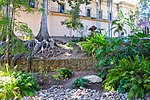Zorro Garden Nudist Colony was an attraction at the 1935-36 Pacific International Exposition in Balboa Park in San Diego, California. It was located in Zoro Garden, a sunken garden originally created for the 1915-16 Panama-California Exposition. Billed as a nudist colony, it was populated by hired performers rather than actual practicing nudists. The women wore only G-strings; the men wore loincloths or trunks. The participants lounged around in their "colony", played volleyball and other games, and performed a quasi-religious "Sacrifice to the Sun God" five times a day. Fair attendees could pay for admission to bleacher-type seats, or they could peek through knotholes in a wooden fence for free. On August 27, 1936, the colony closed, allegedly "after an argument with Exposition officials about finances."Contemporary newspaper accounts indicate the "colony" was composed of actual nudists, but local historian Matthew Alice has stated that the women were "wearing flesh-colored bras, G-strings, or body stockings so everything was zipped up tight." However, the women were indeed topless, as countless un-doctored photographs plainly show.
Nate Eagle, a sideshow promoter who, with partner Stanley R. Graham, created the scandalous Zoro Garden nudist colony. Located in a sunken garden east of the Palace of Better Housing (today's Casa de Balboa), Zoro Garden was, according to the Zoro Garden program, "designed to explain to the general public the ideals and advantages of natural outdoor life." Topless women and bearded men in loincloths read books, sunbathed, and acted in pseudo-religious rituals to the Sun God. According to the program, "Healthy young men and women, indulging in the freedom of outdoor living in which they so devoutly believe, have opened their colony to the friendly, curious gaze of the public." The public's curious gaze quickly turned Zorro Garden into the Exposition's most lucrative outdoor attraction. Despite protests, Zorro Garden lasted for the entire run of the Exposition. The area is now the Zoro Butterfly Garden.












